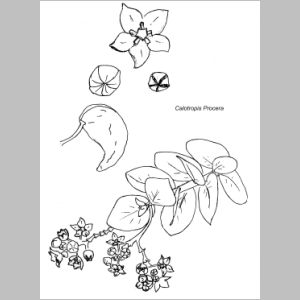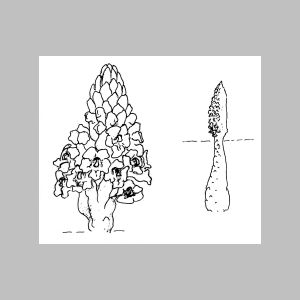Bulletin 4 - March 1978: Wild Flowers in the UAE
Wild Flowers in the UAE
by Pat HarrisCalotropis procera
Family: Asclepiadaceae
European common names: Sodom Apple
Arabic names: Ushar or Shakhr

This poisonous shrub grows to a height of three metres and is instantly recognisable by its large, stiff, obovate leaves which grow in alternate pairs up the stem. Both stem and leaves bleed a copious white sap when cut. The flowers are sturdy, star-shaped and the petals are tipped with mauve on the inside. The seed pod is large and holds small seeds with thistle down tops which are caught in the wind when the pod opens. Camels and goats reputedly do not eat this shrub but there seems to be a variety of grasshopper which does not mind its poisonous latex. (1) In early times 'it was prized as a source of the finest charcoal used in making gunpowder. (3)
The plant blooms in the summer but I had a flowering specimen in November. The seed pods appear in November & December. There is a large bush behind Jashanmals and several smaller. bushes are sheltering under the central reservation bushes on the road to Al Ain. It is very common in Al Ain and I have seen several very large bushes in the main street there.
Cistanche and OrobancheFamily: Orobanchaceae

These succulent root parasitic herbs are very common in Al Ain and the deserts of the U AE .Species can be yellow, violet-blue or brown but our local varieties are generally yellow. Their brilliant yellow spikes which protrude for about 12 inches above the ground, at first glance resemble our own hyacinth, but these plants have no green. They are most readily identified by their hosts, being parasitic on the roots of palm trees, mangrove (Avicennia marina), hurrm (Zygophyllum coccineum) and Chenopodiaceae shrubs. The stem extends deep into the sand and appears to be made up of greyish scales. It is a species of our own Broomrape.
Specimens can be seen at present (January/February) flowering on Umm an Nar, on the roads leading to Al Ain and the odd one can be seen in parts of Abu Dhabi town. Later their blackened stumps will be visible like dead fungi projecting from the sand.
References- JL Cloudsley-Thompson MA, PhD, D.Sc "Desert Life" (Pergamon Press) -p. 30
- Interim Report on the Results of the Oman Flora and Fauna Survey, 1975. Mr J Mandaville -p.25
- Violet Dickson, The Wild Flowers of Kuwait and Bahrain" (Allen and Unwin)
- AM Migahid and MA Hamouda, "Flora of Saudi Arabia" (Riyadh University 1974)
- R Fitter, A Fitter and M Blarney, "The Wild Flowers of Britain and Northern Europe" (Collins).